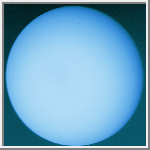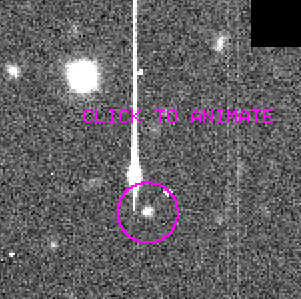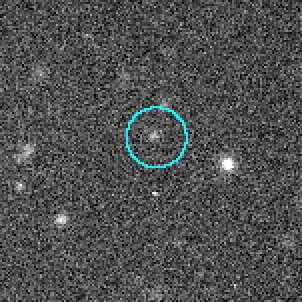Buzzing like a beehive: Uranus now swarming with distant moons

Three years ago, Uranus
was thought to be unusual among the giant planets, being the only one
without `irregular' satellites. Irregular satellites are distant moons
whose orbits are either very non-circular, or very inclined with respect
to the equator of the planet or both. These moons are thought to be bodies
captured into orbit about the planet during the planet's formation some
four and a half billion years ago; Jupiter has 8, Saturn 1, and Neptune 2.
Then, in 1997,
a team of astronomers, using the 5-meter telescope on Palomar Mountain,
discovered
the first two irregular moons of Uranus in a brief search around the
planet using modern technology. Now three more probable satellites have
been discovered over this last summer, bringing the planet's total to 5
irregular and 16 regular moons, making it the most populated planetary
satellite system known.
The newest moons were discovered by an international collaboration
of astronomers, working in July at the Canada-France-Hawaii
Telescope (CFHT) on the lofty 4200m (14,000 feet) peak of Mauna
Kea, Hawaii. The discoverers were Brett Gladman (team leader), Jean-Marc
Petit, and Hans Scholl (all of the Observatoire de la Cote d'Azur in Nice
France), JJ Kavelaars (McMaster University, Canada), and Matthew Holman
(Harvard-Smithsonian Center for Astrophysics, USA). Both Gladman and Kavelaars
were members of the team that had discovered the first two satellites in
1997. Now that those two moon are confirmed to be orbiting the planet, their
previous temporary designations of S/1997 U 1 and S/1997 U 2 have become
the discoverers' proposed names of Caliban and Sycorax, pending final approval
of the International Astronomical Union
in 2000.
Somewhat smaller than the moons discovered in 1997, these new candidate
moons are about 20 times fainter and 4 or 5 times smaller,
 measuring about 20 kilometers in diameter and orbiting Uranus some
10 and 25 million kilometers from that planet's center. These new
satellites were discovered using the worlds largest electronic camera.
The new camera, known as the CFH12k,
images a patch of sky about the size of a full moon. Using this large
electronic detector the team searched the region around the planet
where faint moons were likely to be found.
measuring about 20 kilometers in diameter and orbiting Uranus some
10 and 25 million kilometers from that planet's center. These new
satellites were discovered using the worlds largest electronic camera.
The new camera, known as the CFH12k,
images a patch of sky about the size of a full moon. Using this large
electronic detector the team searched the region around the planet
where faint moons were likely to be found.
These new objects have only been tracked, for a few weeks so their exact
orbits about Uranus are very ill determined. It is possible they
may not even be moons but some other object passing near Uranus.
"Given how they are following the planet exactly it is unlikely that these
are interlopers" says Gladman.
The time-line for this year's discoveries is as follows:
July 17-21/99
The discovery team searches the region around Uranus using the new
CFH12k,
camera at the Canada-France-Hawaii
Telescope. in Hawaii. This new camera system is a mosaic of digital
detectors which takes a picture of a large region of the sky; no other
system in the world images as large a patch of sky to the same dept. The
new camera allowed the team to search over 90 percent of the region of
sky around the planet where satellites might be found. The team immediately
discovered 2 new satellite candidates, which were tracked on 3 of the 4
nights of observation.
July 27/99
The two new moon candidates are announced, and designated S/1999 U
1 and S/1999 U 2 in IAU
Circular #7230 from the Minor
Planet Center (MPC) of the International Astronomical Union (IAU).
In that annoucement, Brian Marsden (MPC, Cambridge) points out that although
the objects could be comets passing by Uranus (known as Centaurs), "the
absence of other slow-moving objects nearby with apparent motions remotely
resembling that of Uranus suggests that the objects are indeed satellites".
July 30/99
The search for moving objects in the images conducted while at the
telescope was accomplished via two different computer programs, one written
by H. Scholl and the other by M. Holman. The use of semi-automatic methods
is necessary due to the immense amount of data generated by the camera
system (about 25 Gigabytes per night). These computer codes compare the
3 images taken at different times and identify `candidate' moving objects;
these candidates are then shown to a human operator who confirms or rejects
them interactively. This human interaction is necessary since the computer
can be easily confused by chance alignments of various features in the
images, especially when looking for very faint objects. Two codes are used
because the two different techniques in their algorithms tend to make them
sensitive to a slightly different set of objects, and thus one will sometimes
find a candidate that the other misses. In the case of S/1999 U 1 and S/1999
U 2, each moon was found by only one of the computer codes during the first
night of observing (July 17/99), allowing us to track these two objects
during the subsequent 3 nights. However, the computer codes need to be
'tuned' to the data to achieve the maximum performance for finding the
faintest possible objects. This was done by Holman in the final week of
July, who then searched the entire set of images a second time. He was
rewarded with the discovery of a third moon candidate (S/1999 U 3), which
had been imaged on July 17th only. Due to having only this single night
of observation, it was not even known which direction around the planet
this third candidate was orbiting! At this point the critical work
was to track these objects so as to watch them move around the planet.
The only way to prove their identity as moons of Uranus is to acquire enough
observations
to prove that the objects are orbiting about the planet rather than
the Sun (and just happened to be passing close by the planet at the time
of observation). The hunt was on!
S/1999 U 3 found by Holman in July 1999 dataset. 
Aug 7-11/99
Before the discovery, August observing time at the famous Palomar
5-meter telescope in California had been acquired by P. Nicholson (Cornell),
Gladman, and J.A. Burns (Cornell) for the express purpose of tracking any
candidate satellites discovered at the wide-field CFHT. During this period
all of the candidates were tracked, proving that they were remaining in
the vicinity of the planet, significantly increasing the chances that all
3 were in fact moons of the planet. S/1999 U 3 was shown to be moving almost
radially away from the planet, as projected on the sky, indicating that
we are seeing its orbit almost edge on.
Sept 1-2/99
Gladman, observing with D. Davis and C. Neese (Planetary Science Institue,
Tucson) re-acquires all three candidates from the Kitt Peak 4-meter telescope
during a portion of time otherwise unusable in an asteroid-survey project.
The objects are still tracking the planet. Observations are reported to
the Minor Planet Center Sept. 15. At this point orbital acceleration of
the two closest moons around Uranus can be detected in the data, further
increasing the certainty of their identification as moons of the planet.
Sept 4/99
S/1999 U 3 is formally announced in IAU
Circular 7248, at which time the identity of the objects as satellites
is still not 100 percent secure.
Sept 15/99
Using the Kitt Peak obersvations of Sept 2, calculations by B. Marsden
of the Minor Planet Center show that S/1999 U 2 is confirmed as a satellite.
Oct 14 and 15/99
Holman and Kavelaars recover 1999 U 1 and U 3 using the Kitt Peak 4-meter
telescope. The planetocentric orbital curvature seen for these two objects is
now evident.
Winter 1999-2000
The planet and its satellites disappeared behind the Sun until
late March 2000. Predictions for the positions of the satellites in the
spring are made by (1) Brian Marsden of the
IAU Minor Planet Center ,
(2) Robert Jacobson of the
Jet Propulsion Laboratories, and
(3) Bill Grey of
Project Pluto.
May 27-29, 2000
Holman, Gladman, and Kavelaars recover 1999 U 3 with the Kitt Peak 4-m
about 1-2 arcminutes away from its position as predicted by above workers.
June 28-29, 2000
Holman, observing
at the 2.5-m Nordic Optical Telescope
with members of a Norwegian team including T. Grav, N. Haug, K. B. Klepper,
and J. Holman, recovers both S/1999 U 1 and re-observes U 3.
The identification of these two objects as satellites is now certain.
France Contacts:
Brett Gladman: Observatoire de la Cote d'Azur, 011 33 4 9200 3191,
email gladman@obs-nice.fr
URL:
http://www.obs-nice.fr/gladman
Jean-Marc Petit: Observatoire de la Cote d'Azur, 011 33 4 9200
3089, email petit@obs-nice.fr
URL:
http://www.obs-nice.fr/petit/petit.html
Hans Scholl: Observatoire de la Cote d'Azur, 011 33 4 9200 3126, email
hscholl@obs-nice.fr
Canada Contact:
JJ Kavelaars: McMaster University, Hamilton, 905-525-9140x27106, email:
kavelaars@physics.mcmaster.ca, URL:http://pinks.physics.mcmaster.ca/
USA Contacts:
Matthew Holman: Harvard-Smithsonian Center for Astrophysics, Cambridge,
MA, 617-496-7775, email: mholman@cfa.harvard.edu
Philip Nicholson: Cornell University, 607-255-8543, nicholso@astrosun.tn.cornell.edu
Joseph A. Bruns: Cornell University, 607-255-7186, jab16@cornell.edu

 measuring about 20 kilometers in diameter and orbiting Uranus some
10 and 25 million kilometers from that planet's center. These new
satellites were discovered using the worlds largest electronic camera.
The new camera, known as the CFH12k,
images a patch of sky about the size of a full moon. Using this large
electronic detector the team searched the region around the planet
where faint moons were likely to be found.
measuring about 20 kilometers in diameter and orbiting Uranus some
10 and 25 million kilometers from that planet's center. These new
satellites were discovered using the worlds largest electronic camera.
The new camera, known as the CFH12k,
images a patch of sky about the size of a full moon. Using this large
electronic detector the team searched the region around the planet
where faint moons were likely to be found.

